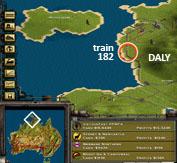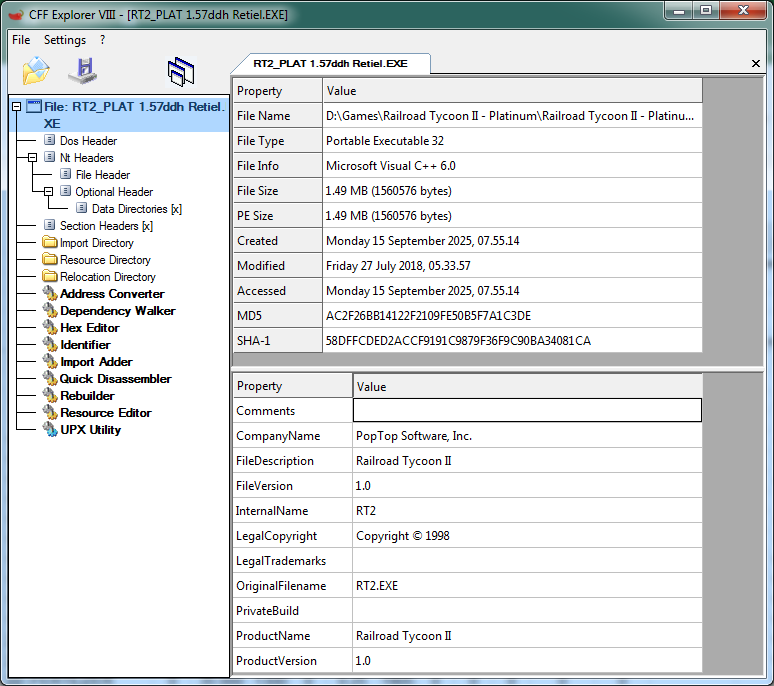-
Posts
18 -
Joined
-
Last visited
-
Days Won
1
Everything posted by RRslowM
-

1850 WA save crashing after almost 100 in-game years...
RRslowM replied to Gardiner's topic in Railroad Tycoon 2 Discussion
I couldn't get rid of this train -

1850 WA save crashing after almost 100 in-game years...
RRslowM replied to Gardiner's topic in Railroad Tycoon 2 Discussion
I found it. The train stops when the following stations are removed: "Darwin", "Darwin Power Steel". Note: This happens irregularly, differently each time, as if the train's route stations were changing. -

1850 WA save crashing after almost 100 in-game years...
RRslowM replied to Gardiner's topic in Railroad Tycoon 2 Discussion
No. I've never played for so long or made so many trains) -

1850 WA save crashing after almost 100 in-game years...
RRslowM replied to Gardiner's topic in Railroad Tycoon 2 Discussion
Your file number 12 also crashes for me. I tried running the game on the following versions: 1.55 1.56 1.57ddh -

Detailed Questions About the Math of Demand
RRslowM replied to Thomas Crampton's topic in Railroad Tycoon 2 Discussion
1. The demand in the game menu is restored at a constant rate: 1-(11)-2-(7)-3-(4)-4-(4)-5-(3)-6-(3)-7-(2)-8-(2)-9 (the number of months is indicated). When delivering goods, it may occupy intermediate values. 2. The fractional part of the demand number is discarded. Two or more identical plants covered by one station will have the following demand: 1) the fractional part of the number will be discarded 2) the obtained results will be added up (this is the Conversions sheet). Therefore, in the "Conversions" table, values less than 1 will always be equal to 0. The data from the "Cargo" sheet is first summed up, and then the fractional part of the resulting sum is discarded (this is for the towns and cities). Result/max in the game menu: 0.0 / 4; For industry, it's not recovering (demand from the Conversions sheet). For cities, it's recovering (demand from the Cargo sheet). 1.0 / 5; 2.0 / 6; 3.0 / 7; 4.0 / 8; 5.0 and above / 9. 3. Several stations cover a single plant, and the plant's demand is divided equally. For example, if demand is 4.0, and 3 stations are involved, each station will have 4.0/3 = 1 (the fractional part of the number is discarded). 4. Deliver to the station the amount of cargo per year corresponding to the demand number from the Conversions sheet - the demand in the menu will be kept at 3. Deliver twice as much - the menu will maintain a value of 1. Deliver half as much - the menu grows to the maximum (see maximum in paragraph 2). Note: production runs slightly faster than indicated in the menu (1 per year, in the game menu = during a crash it will be 1.1; during a boom it will be 1.6). -
How are transcontinental missions accomplished?
-
-
A Fuel Rules 1) waste to landfills - will electric locomotive fuel be cheaper? 2) lumber (later cement), steel or diesel - bridges and fuel for diesel locomotives?
-
I understand that the map tells a story. I don't speak the language, so they'll skip a lot of messages without understanding their meaning. So I need to know: 1. What tasks lie ahead of me to win? 2. What obstacles await me on the way to completing the tasks?
-
I want to play your map. I have no problem launching it. My problem is that I don't speak English. Could you send me some information so I can translate it separately so I can navigate your map better? Then I could see what you're talking about in real life and report back later with my observations.
-
Unfortunately, I don't understand this. This requires a specialist in this field. But I think the game is compiled directly into machine instructions for the processor, not into intermediate code that is then interpreted during runtime. Decompilation will definitely require a lot of time and high qualifications from the developer. ___________________ Decompilation will begin with obtaining the assembler code, and then (using software tools and the high qualifications of the person who will perform it) high-level structures (for example, the C language) will be restored.
-
To fix bugs and improve the game, you can follow the same approach as with Caesar III (create julius.exe and augustus.exe. They use the original game's files). 1. Decompile the original RRT2 v1.56. 2. Fix the bugs and create a new RRT2.exe (compatibility with RRT2 v1.56 is maintained). 3. Add new features and create a new RRT2.exe (compatibility with RRT2 is not maintained). The new RRT2.exe will use the files of the original v1.56 game. This means you're still buying the original game and using the custom-made RRT2.exe.
-
Yes.
-
In the previous message, I forgot to add one more year to the total costs (for the first line it will be 262 + 23.7 = 285) PS: New locomotive, displays 0 year. 1 year is added on January 1st.
-
Additional information about locomotives: 1) Locomotive speed decreases by 0.5% each year 2) Locomotive maintenance costs increase by 8% each year 3) Locomotive fuel consumption increases by 2% each year PS: The percentages slowly deviate from the above figures each year. Analysis of all locomotives from the point of view of minimum costs (purchase and maintenance): years $ $/year 2-6-2 Prairie 11 262 23.7 F3A+B 16 707 44.1 Alco PA-1 14 583 40.7 4-6-4 Hudson 12 636 55.1 Trevithick-1 5 47 9.0 Stephenson Rocket 7 65 9.8 2-4-0 John Bull 7 88 12.0 0-4-0 Dewitt Clinton 8 67 8.8 4-2-0 Prussian 8 124 14.7 4-4-0 American-C 12 137 11.3 4-2-2 Iron Duke 12 235 20.0 0-4-0 A3 12 203 17.6 4-4-0 8-Wheeler 14 167 12.3 2-4-0 Vulcan 11 98 8.7 2-8-0 Consolidation 10 164 16.3 3-Track Shay 6 177 27.6 4-8-0 Mastodon 9 209 24.3 4-6-0 Ten-Wheeler 10 216 22.0 2-6-0 Mogul 10 262 25.0 1-3 BoBo 15 233 15.7 4-4-2 Atlantic 9 315 34.6 2-6-0 Camelback 11 228 19.8 4-6-2 Pacific 10 394 41.4 0-10-0 Class G10 6 402 61.9 2-6-2 Prairie 11 262 23.7 4-4-0 D16sb 11 203 19.0 2-10-0 Class 13 H 7 407 59.8 USRA 0-6-0 11 284 27.1 2-8-2 Mikado 8 477 58.2 Be 4/6 II 9 203 21.5 4-6-0 Class B12 13 423 33.0 Ee 3/3 10 150 14.5 Class 1045 16 255 16.3 USRA 0-8-0 9 328 35.1 Class A4 Mallard 13 578 44.9 GG1 15 773 50.6 Class E18 10 316 32.1 4-6-4 Hudson 12 636 55.1 4-8-4 Daylight 11 710 64.4 4-6-4 J3A Streamliner 12 759 63.3 Ae 8/14 12 631 53.6 4-8-8-4 Big Boy 9 1281 142.9 Class 1020 10 380 37.0 4-4-4-4 T-1 13 827 65.5 F3A+B 16 707 44.1 Alco PA-1 14 583 40.7 F9 17 882 51.8 GP9 18 603 33.2 TGVx 13 2454 189.8 E 69 13 248 19.0 GP18 16 655 41.1 V200 12 484 41.9 Penn. E44 16 985 60.9 Class 55 Deltic 22 1172 53.0 Shinkansen Bullet 12 1905 152.9 FP45 20 915 45.7 SD45 14 775 53.7 SDP40 16 782 49.2 E60CP 16 829 52.1 TGV 13 2174 169.7 Class E111 19 992 52.8 E656 FS 14 626 43.4 Dash-9 20 1193 59.1 AMD-103 16 1129 69.5 Thalys Bullet 14 2787 196.8 Eurostar 19 4030 207.2 Class 232 15 1349 91.1 BD 18 201 9 1345 145.4 Brenner 11 3897 360.4 Mag-Lev TBX-1 14 7000 500.3
-
Place many small stations throughout the city. Each station should only cover one house. You will see that each house produces its own railway car (mail/passenger) separately from other houses. _____________________________________ menu crashed normal boom 0.2 0.22 0.24 0.27 0.29 0.32 0.4 0.44 0.48 0.53 0.59 0.64 0.6 0.67 0.73 0.80 0.88 0.96 menu - production speed, which can be viewed by right-clicking on an object (house); economy (crashed, ..., boom) is a game fact. The economy from "crashed" to "boom" accelerates production by 1.44 times.
-

How does grade affect acceleration?
RRslowM replied to rkagerer's topic in Railroad Tycoon 2 Discussion
Don't doubt it. Everything will work as your intuition dictates. Downhill - rapid acceleration. Uphill - strong deceleration. -
One house produces 0.2 passengers per year (for example). This house will create one passenger train car after 5 years. Each house begins production at a random position. If production started simultaneously, five houses would produce no passengers for five years, and then five train cars would immediately appear. _________________________ PS: I use Google Translate. My native language is Russian.



